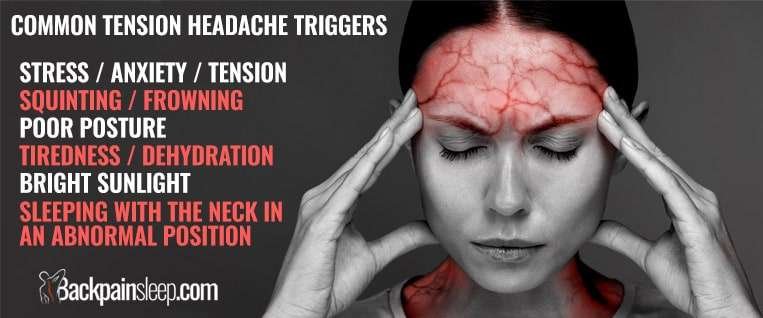Tension Headaches Cause
We all have them, some more than others, but there is a lot we can do to minimize or even stop them in their tracks with a few simple changes. Our lifestyles and bad habits are the leading tension headaches cause. Excessive frowning or repeatedly clenching and unclenching jaws forces the neck and facial muscles to tighten, which has a knock-on effect on surrounding muscles.
These bad habits are classic tension triggers, but as we know… bad habits can be broken, which means we can go a long way to preventing them in the first place, and if you’re plagued with headaches, like so many of us are, that’s great news. Did you know that the two simplest changes that can have the biggest impact are changing your pillow and using a simple, inexpensive neck and shoulder massager on a daily basis, you can read about these below. This is what we did and our instances of tension headaches dropped significantly… after years of wasting money on every pain relieving gadget imaginable. It’s so simple when stripped back. Relieve tension with massage, sleep on a pillow that supports you.

Bad posture
Bad posture has been identified as one of the leading causes of neck pain and tension headaches cause. An uncomfortable working or reading position is stressful, and holding this for a long time without moving will have painful repercussions, guaranteed. The global surge of text neck symptoms is a prime example of the result of bad posture when using electronic devices. Bad posture can be corrected immediately, yet many of us remain in uncomfortable positions even though we know we should move; we’re all guilty of it. Here are some examples
- Jutting our heads forward using cell phones or laptops (text neck)
- Remaining seated for hours, in the office, at home, or driving.
- Video gaming for hours, sometimes days on end.
- Sleeping with your head unsupported every single night
- Sleeping in the wrong position, especially on your front
- Slouching watching TV
The examples above all have one thing in common; taking a break can prevent a headache. Correcting your posture has a multitude of other benefits. It will also help minimize muscle strains, neck pain, back pain, head pain, and your joints will thank you for it, too, as you’ll reduce your chances of injuring yourself at work or exercising.
Sleeping
Yes… Sleeping. Sleeping with your neck in an awkward or unsupported position is considered one of the leading tension headaches cause. At backpainsleep, we consider it the leading cause of our own headaches. We cannot emphasize enough the dramatic effect a simple change of pillow had on reducing neck pain and tension headaches. It virtually eliminated them. If you suffer from frequent tension headaches or neck pain and have never considered that your pillow could be the culprit, we’d urge you to.
If your neck isn’t supported correctly while you sleep, your neck muscles have to work to keep you aligned… think about all the hours you’re in bed, night after night, month after month, year after year… It may feel like your neck muscles are relaxed on your trusty old pillow, but if you’re waking with neck pain or developing frequent headaches on a regular basis, an upgrade may be long overdue. We shout this from the rooftops because we know personally the difference it can make to your everyday life.
Before moving forward, we’ll Introduce the pillow upgrade to end all pillow upgrades. We’ve run out of superlatives describing the benefits of this Therapeutica Pillow, if you would like to read more about it, please look at this article which explains why it’s quite simply the best pillow we have ever used for relieving and preventing a number of neck-related issues and headaches.
✅ TENSION HEADACHES
✅ NECK PAIN
✅ SHOULDER PAIN
✅ PERFECT FOR SIDE-SLEEPERS
✅ NON-ALLERGENIC / NON-TOXIC
Super Frowning
We instinctively know that frowning will inevitably lead to suffering from a headache and tight, tense neck and facial muscles. Frowning can be very hard to control, backpainsleep are a prime example. We noted which tasks and activities involved us ‘super-frowning.’ We were gob-smacked to learn that the one activity we use for prime relaxation was the worst activity for frowning and triggering awful headaches. What was it? Playing the piano! Some slow-motion video taken on a phone was quite the eye-opener showing clearly how much tension was in the neck and facial muscles while playing. Aside from being funny (watching someone playing piano looking like they’re constantly smelling bad farts), it was actionable evidence that the activity was causing problems. If you know an activity is causing you to frown, try and get some video of yourself doing so… it’s quite the deterrent.
Teeth Grinding
This is a bad, bad habit. Teeth grinding… it even sounds bad. Grinding down your own teeth… with your own teeth. Here’s a shortlist of some symptoms this bad habit is going to help you aggravate if you don’t take action.
- Tension headaches
- Face pain
- Earache
- Tooth wearing & tooth loss
- Jaw Issues like TMD
- Dreadful sleep quality (for you and a partner)
As you can see, teeth grinding (also known as bruxism) can cause a wide range of painful issues, not just headaches, so it’s important to see a dentist and/or doctor if you’re suffering from any of the above symptoms. There are effective treatments available, like mouth guards and splints that impair the grinding and clenching of teeth whilst minimizing tooth wear and alleviating pain. Teeth grinding can take some time to get control of but it’s 100% worth trying.
Stress
We can say with a degree of certainty that stress plays a pivotal role in triggering tension headaches. Stress and tension are the best of friends that play very well together, and if not addressed, it’s a bond that will never be broken. Stress-related issues are far-reaching, but we’re only going to focus on some common stress-related headaches. Everyday stresses like lack of sleep, straining the eyes, loud music or noises, not eating properly, not staying hydrated, drinking too much caffeine, and sudden stopping of caffeine are common stressors that accumulate as the day progresses. Generally speaking, if we’ve had a long stressful day, we’re more than likely to develop a throbbing tension headache. It may seem obvious after detailing the above, but some simple tweaks that can really minimize stress are;
- Get adequate sleep.
- Give your eyes a time-out to prevent straining, get your eyes tested
- Eat when you’re hungry, don’t wait until you’re ravenous
- Drink plenty of water
- Monitor your caffeine intake
- Count to 10 if your being provoked
- Learn how to take a few deep stress busting breaths
Tension Headache Massage
When it comes to relieving tension headaches naturally, this tried, tested and ridiculously cheap shiatsu massager can make a massive difference to your daily life. We shout this from the rooftops because it works… it just works. These massagers are so affordable, and the benefits of a daily neck and shoulder massage are absolutely priceless. Please click the link below and read the reviews, they speak for themselves ;O)
✅ OCCIPITAL NEURALGIA
✅ RELIEVING NECK / SHOULDER PAIN
✅ TENSION HEADACHE RELIEF
✅ TENSION HEADACHE PREVENTION
✅ PERFECT THERAPY BEFORE SLEEP
And… breathe
This simple, stress-busting breathing method works quickly and can be done anywhere.
Make this a good habit, a mini-timeout every day pays dividends and it can be done anywhere, standing, sitting, or lying down. Start by getting as comfortable as possible.
If lying down, move your arms away from your sides a bit, palms up. Straighten your legs and bend your knees a little to keep your feet flat on the floor. If sitting, allow your arms to rest on the chair arms or your thighs.
Either standing or sitting, keep both feet flat on the ground and about hip-width apart.
- Breathe into your belly, not your chest, don’t force it.
- Breathe in through your nose and out through your mouth.
- Inhale and exhale gently at a tempo that suits you. 3-5 seconds in, 3-5 seconds out is a good start.
- Then, without stopping, let it flow out gently until you’ve fully exhaled, pause a little, and inhale.
- Keep doing this for 2 to 4 minutes if possible. Even 1 minute of breathing makes a difference.
There was a time when we didn’t pay the slightest attention to breathing; we all breathe automatically, so what’s the point, right? Breathing takes care of itself! Well, we couldn’t have been more wrong. There’s the breathing that we don’t think about and the breathing that we DO think about. Once we discovered the amazing benefits of simply taking a few deep breaths, we kicked ourselves for not exploring it sooner. For us, one of the biggest benefits of learning to wind down with breathing has been the ability to drift off to sleep quickly.
Conclusion
When you strip it back, the actions above are a breeze to implement, and they can have a dramatic effect on your headaches and subsequent quality of life. Change your pillow, be mindful of your posture, take a few deep breaths, it’s simple. Reducing physical, emotional, and environmental stress will ultimately reduce muscle tension, leading to pain relief. Try to maintain a healthy lifestyle by keeping to a regular regime, busting a few bad habits, eating correctly, and exercising, and stretching a little every day. Implement a few changes and you could be well on your way to feeling pretty damn good every day. Sounds good.
Last prices update on 2025-06-27






